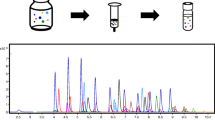Abstract
In Ion Mobility Spectrometry (IMS), the analysis of aqueous samples is impaired by the mandatory removal of water. Before the sample enters the IMS system, the analyte must be extracted from water. For this purpose, the stir bar sorptive extraction (SBSE) method with polydimethylsiloxane (PDMS) as sorbent was chosen for the enrichment of alachlor, lindane and diuron from aqueous samples. Thermal desorption and detection of the analytes were carried out by conventional IMS coupled with an upstream thermal desorption system (TDS). K0-values were determined using optimized instrumental parameters e.g. gas flows, temperatures and shutter grid width. Furthermore, influence of the experimental parameters (e.g. pH, stirring time, sodium chloride) on enrichment degree of the analytes at the PDMS sorbent has been investigated. For calibration, non-linear second-order calibration functions were applied and the formulas for the Limit of Detection and Limit of Quantification were derived. For example, a Limit of Detection of 5 μg kg−1 and Limit of Quantification of 16 μg kg−1 were obtained for lindane.





Similar content being viewed by others
References
Ternes TA (1998) Occurrence of drugs in German sewage treatment plants and rivers. Water Res 32:3245–3260
Buser H-R, Poiger T, Mueller MD (1998) Occurrence and fate of the pharmaceutical drug diclofenac in surface waters: rapid photodegradation in a lake. Environ Sci Technol 32:3449–3456
Hirsch R et al (1999) Occurrence of antibiotics in the aquatic environment. Sci Total Environ 225:109–118
van der Hoff GR, van Zoonen P (1999) Trace analysis of pesticides by gas chromatography. J Chromatogr A 843:301–322
Chowdhury AR, Venkatakrishna-Bhatt H, Gautam AK (1987) Testicular changes of rats under lindane treatment. Bull Environ Contam Toxicol 38:154–156
Rawlings NC, Waldbillig (1998) Effects of the pesticides carbofuran, chlorpyrifos, dimethoate, lindane, triallate, trifluralin, 2,4-D, and pentachlorophenol on the metabolic endocrine and reproductive endocrine system in ewes. J Toxicol Environ Health 54(1):21–36
Fiedler H, Borja-Aburto V (2003) Persistent organic pollutants. Springer Verlag, Berlin Heidelberg
Jones KC, De Voogt P (1999) Persistent organic pollutants (POPs): state of the science. Environ Pollut 100(1–3):209–221
Hillenbrand T, Marscheider-Weidemann F, Strauch M (2006) Datenblatt Lindan (−HCH)
Dubus I, Hollis J, Brown C (2000) Pesticides in rainfall in Europe. Environ Pollut 110(2):331–344
Gonzalez-Barreiro C et al (2000) Optimisation of alachlor solid-phase microextraction from water samples using experimental design. J Chromatogr A 896(1–2):373–379
Manz M et al (2001) Persistent organic pollutants in agricultural soils of central Germany. Sci Total Environ 277(1–3):187–198
Tuovinen K, Kolehmainen M, Paakkanen H (2001) Determination and identification of pesticides from liquid matrices using ion mobility spectrometry. Anal Chim Acta 429(2):257–268
Baltussen E et al (1999) Stir bar sorptive extraction (SBSE), a novel extraction technique for aqueous samples: theory and principles. J Microcol Sep 11(10):737–747
Pawliszyn Jb (1997) Solid phase microextraction: theory and principles. Wiley-VCH, New York, pp. 275
Leon VM et al (2003) Analysis of 35 priority semivolatile compounds in water by stir bar sorptive extraction-thermal desorption-gas chromatography–mass spectrometry. I. Method optimisation. J Chromatogr A 999:91–101
Walendzik G, Baumbach J, Klockow D (2005) Coupling of SPME with MCC/UV–IMS as a tool for rapid on-site detection of groundwater and surface water contamination. Anal Bioanal Chem 382(8):1842–1847
Lokhnauth JK, Snow NH (2006) Stir-bar sorptive extraction and thermal desorption-ion mobility spectrometry for the determination of trinitrotoluene and 1, 3, 5-trinitro-1, 3, 5-triazine in water samples. J Chromatogr A 1105:33–38
Orzechowska GE, Poziomek EJ, Tersol V (1997) Use of solid phase microextraction (SPME) with ion mobility spectrometry. Anal Lett 30(7):1437–1444
Rearden P, Harrington PB (2005) Rapid screening of precursor and degradation products of chemical warfare agents in soil by solid-phase microextraction ion mobility spectrometry (SPME-IMS). Anal Chim Acta 545(1):13–20
Rearden P et al (2007) Fuzzy rule-building expert system classification of fuel using solid-phase microextraction two-way gas chromatography differential mobility spectrometric data. Anal Chem 79(4):1485–1491
R Development Core Team (2011) R: a language and environment of statistical computing. Available from: http://www.R-project.org
Normenausschuss Wasserwesen (NAW) im DIN, Wasserbeschaffenheit—Kalibrierung und Auswertung analytischer Verfahren und Beurteilung von Verfahrenskenndaten—Teil 2: Kalibrierstrategie für nichtlineare Kalibrierfunktionen zweiten Grades. Deutsche Norm DIN ISO 8466–2, Berlin (Juni 2004).
Normenausschuss Materialprüfung (NMP) im DIN, Chemische Analytik—Nachweis-, Erfassungs- und Bestimmungsgrenze unter Wiederholbedingungen—Begriffe, Verfahren, Auswertung. Deutsche Norm DIN 32645, DIN Deutsches Institut fr Normung e.V., Berlin, Berlin (November 2008).
Acknowledgments
The authors gratefully acknowledge Schumann Analytics, Einbeck, Germany for the technical support. Thanks are due to GERSTEL GmbH & Co. KG, Mülheim, Germany for the supply of SBSE with PDMS fiber.
Author information
Authors and Affiliations
Corresponding author
Rights and permissions
About this article
Cite this article
Zscheppank, C., Telgheder, U. & Molt, K. Stir-bar sorptive extraction and TDS-IMS for the detection of pesticides in aqueous samples. Int. J. Ion Mobil. Spec. 15, 257–264 (2012). https://doi.org/10.1007/s12127-012-0097-x
Received:
Revised:
Accepted:
Published:
Issue Date:
DOI: https://doi.org/10.1007/s12127-012-0097-x




